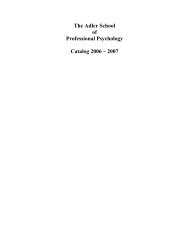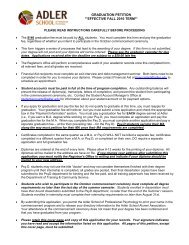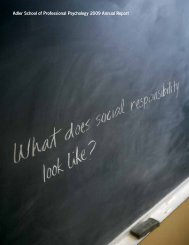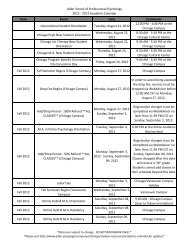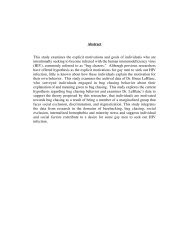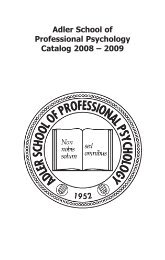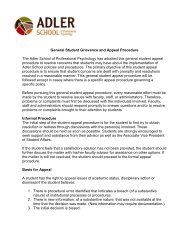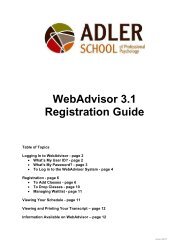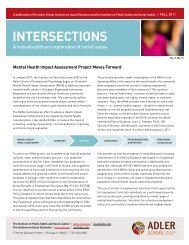Spring 2008 - Adler School of Professional Psychology
Spring 2008 - Adler School of Professional Psychology
Spring 2008 - Adler School of Professional Psychology
Create successful ePaper yourself
Turn your PDF publications into a flip-book with our unique Google optimized e-Paper software.
INTERSECTIONS<br />
A Publication <strong>of</strong><br />
the Institute on<br />
Social Exclusion<br />
Volumn 1, Number 2 A Transdisciplinary Exploration <strong>of</strong> Social Exclusion<br />
<strong>Spring</strong> <strong>2008</strong><br />
Addiction<br />
and Social Exclusion<br />
Elisabeth Houston, MS, MCP<br />
Social Exclusion (SE) refers to “processes by<br />
which entire communities… are systematically<br />
blocked from rights, opportunities and<br />
resources… that are normally available to<br />
members <strong>of</strong>… society, which are key to social<br />
integration.” (Todman, <strong>2008</strong>.) Some <strong>of</strong> its<br />
dimensions include poverty, unemployment,<br />
homelessness, crime, political disempowerment,<br />
social alienation, marginalization and stigma,<br />
mental and physical disease and lack <strong>of</strong> access<br />
to healthcare, education and basic nutrition.<br />
Empirical studies <strong>of</strong> SE suggest that it is a discreet<br />
and unique psychological experience. Several<br />
laboratory experiments simulated brief episodes<br />
<strong>of</strong> SE and found that subjects reacted with<br />
numbness, followed by deconstructed states in<br />
which time perception and self-awareness<br />
were altered, meaninglessness and lethargy<br />
exacerbated, self-regulation impaired and selfdefeating<br />
behaviors facilitated. (Baumeister, 2005;<br />
Twenge, Catanese and Baumeister, 2002; Twenge,<br />
2003.) These studies also drew on animal research<br />
indicating that challenges to social connections<br />
are threats to physical safety within one’s group<br />
and that the systems that process physical pain<br />
mediate these experiences. (MacDonald and<br />
Leary, 2005.) These researchers all concluded that<br />
social belonging must represent a fundamental<br />
human need, if not drive.<br />
Given this framework, is the socially deviant and<br />
self-defeating behavior <strong>of</strong> addiction another<br />
dimension <strong>of</strong> SE In answer, one theory proposes<br />
that SE is a social representation that dominant<br />
groups promote in order to maintain their<br />
positions in society; and, as such, it <strong>of</strong>ten focuses<br />
on issues related to self-control. Particularly in<br />
Protestant-Calvinist based societies, the perceived<br />
failures <strong>of</strong> addicts and alcoholics to exercise<br />
socially-requisite self-discipline over drugs and<br />
alcohol relegate them to out-group status. (Jaffe<br />
and Staerkle study in do Amaral Madureira, 2007.)<br />
More broadly, societies and cultures that<br />
incompletely incorporate the use <strong>of</strong> drugs and<br />
alcohol into accepted social bonding or religious<br />
rituals (primarily Western cultures) stigmatize<br />
substance abusers, viewing them as threats to the<br />
social order and defining them as deviants, to<br />
whom a disease model may or may not apply.<br />
(Durrant and Thakker, 2003; Denzin, 1993.)<br />
Epidemiological statistics regarding addiction<br />
among some otherwise frequently sociallyexcluded<br />
populations suggest that the presence<br />
<strong>of</strong> other SE factors may exacerbate the<br />
consequences and stigma <strong>of</strong> substance abuse. In<br />
the U.S., Hispanics and African-Americans are<br />
over-represented in measures <strong>of</strong> drug-related<br />
harm, but differences in the reported prevalence<br />
<strong>of</strong> use do not appear to explain this phenomenon.<br />
(Durrant and Thakker, 2003.)<br />
National data sets indicate that alcoholism<br />
prevalences are actually highest for white<br />
Americans and lowest for African-Americans, with<br />
Hispanics falling in the mid-range. Yet data also<br />
show consistent and significant racial/ethnic<br />
differences in such alcohol-related health<br />
consequences as cirrhosis <strong>of</strong> the liver and fetal<br />
alcohol syndrome. These same groups also<br />
demonstrate significantly higher rates <strong>of</strong> drugrelated<br />
emergency room visits, drug-related<br />
arrests and incarceration. (Substance Abuse and<br />
Mental Health Services Administration, 2001;<br />
Wallace, 1999.)<br />
Some researchers argue that, while these<br />
disparities have <strong>of</strong>ten been attributed to individual<br />
and interpersonal risk factors, only communitylevel<br />
structural factors, including socioeconomic<br />
status and “contextual-level risk factors to<br />
which black and Hispanic-Americans are<br />
disproportionately exposed” can explain them.<br />
(Wallace, 1999.) These factors include high levels<br />
<strong>of</strong> drug availability (“hyperavailability”) and<br />
disproportionate levels <strong>of</strong> liquor marketing and<br />
advertising in minority neighborhoods; differential<br />
application <strong>of</strong> laws regarding substance abuse;<br />
and racial pr<strong>of</strong>iling accompanied by heavier<br />
policing in socially-disadvantaged areas. One<br />
conclusion is that:<br />
“If the various kinds <strong>of</strong> harm associated with<br />
the use <strong>of</strong> drugs are related to factors such<br />
as neighborhood disadvantage, stress,<br />
poverty and discrimination, then because<br />
minority groups tend to be differentially<br />
affected by these factors, they can<br />
potentially account for cultural disparities<br />
in drug-related problems….” (Durrant and<br />
Thakker, 2003.)<br />
A vast literature that seeks to capture and<br />
articulate the subjective and qualitative aspects <strong>of</strong><br />
addiction seems to bolster this more empirical<br />
argument. The concept <strong>of</strong> the self is central to<br />
these accounts, which explore the personal,<br />
psychosocial, cultural/historical, and even biological<br />
experience <strong>of</strong> addiction (i.e., its inner experience).<br />
As one study explains:<br />
“All theories <strong>of</strong> drug use… whether implicitly<br />
or explicitly, involve the notion <strong>of</strong> selfhood.<br />
Regardless <strong>of</strong> what level <strong>of</strong> analysis…<br />
is emphasized, what ultimately needs to be<br />
explained is why individuals choose to<br />
initiate drug use, continue to use drugs, give<br />
up or start using drugs again after a period<br />
<strong>of</strong> abstinence… [R]egardless <strong>of</strong> how<br />
impaired an individual’s capacity for choice<br />
is…, or how limited their choices might be<br />
(e.g., as the result <strong>of</strong> adverse social<br />
conditions), the self as an executive agent is<br />
still involved… even if those decisions are<br />
influenced by a myriad <strong>of</strong> factors that may or<br />
may not be in an individual’s power<br />
to change.” (Durrant and Thakker, 2003,<br />
italics original.)<br />
This extensive body <strong>of</strong> writing on addiction and<br />
the self comprises four categories: a narrative<br />
literature illustrating the need for the “spoiled”<br />
addictive self to possess a story linking the<br />
individual to society; a sociological/ anthropological/
ecological literature placing the addicted self<br />
within the cultural fabric; a psychoanalyticallyoriented<br />
literature exploring etiology; and a<br />
political/philosophical literature that questions the<br />
nature and view <strong>of</strong> the self needing restoration.<br />
Virtually all <strong>of</strong> this literature speaks to the ways in<br />
which subjective experiences <strong>of</strong> addiction and<br />
structural factors interrelate. For example, one<br />
seminal work, anthropologist and participantobservor<br />
Phillipe Bourgois’ “In Search <strong>of</strong> Respect:<br />
Selling Crack in El Barrio” (1995), reveals a culture<br />
in which a changing global economy and limited<br />
employment options restrict jobs for minimallyeducated<br />
Puerto Rican males living in New York<br />
City’s East Harlem. Their situation prevents them<br />
from living out culturally-dictated “machoproletarian<br />
dreams—[so that] they find<br />
themselves propelled headlong into an explosive<br />
confrontation between their sense <strong>of</strong> cultural<br />
dignity versus the humiliating interpersonal<br />
subordination <strong>of</strong> service work.” (Bourgois, 1995.)<br />
Without the pr<strong>of</strong>essional capabilities, social skills,<br />
knowledge <strong>of</strong> dress codes or mores requisite to<br />
the <strong>of</strong>fice culture <strong>of</strong> the service economy to which<br />
they are relegated, these men find that their<br />
“oppositional street identity is dysfunctional….<br />
Street culture is in direct contradiction to the<br />
humble, obedient modes <strong>of</strong> subservient social<br />
interaction that are essential for upward mobility<br />
in high-rise <strong>of</strong>fice jobs.” (Bourgois, 1995.) In this<br />
situation, drug dealing, with attendant use,<br />
becomes an alternative career path, a route to<br />
maintaining one’s dignity as well as earning a living.<br />
The author interprets:<br />
“[D]rugs are not the root <strong>of</strong> the problems…;<br />
they are the epiphenomenal expression <strong>of</strong><br />
deeper, structural dilemmas. Self-destructive<br />
addiction is merely the medium for<br />
desperate people to internalize their<br />
frustration, resistance and powerlessness….<br />
The problem <strong>of</strong> substance abuse in the<br />
United States is… because <strong>of</strong> a polarization<br />
<strong>of</strong> the structural roots that generate selfdestructive<br />
behavior and criminal activity.<br />
The economic base <strong>of</strong> the traditional working<br />
class has eroded…. Greater proportions<br />
<strong>of</strong> the population are being socially<br />
marginalized. The restructuring <strong>of</strong> the world<br />
economy,… as well as the exhaustion <strong>of</strong><br />
social democratic models for public sector<br />
intervention on behalf <strong>of</strong> the poor, have<br />
escalated inequalities around class, ethnicity<br />
and gender.” (Bourgois, 1995.)<br />
In advocating for a reduction in the “economic<br />
dynamism” <strong>of</strong> the drug economy and<br />
transformation <strong>of</strong> the “fragility and hostility” <strong>of</strong> the<br />
legal entry-level labor market, Bourgois (1995)<br />
states: “The alternative, <strong>of</strong> course, is to lock<br />
everyone up.”<br />
This way <strong>of</strong> looking at addiction resonates with<br />
that <strong>of</strong> policymakers in countries outside the U.S.<br />
that have embraced SE thinking. It implies that<br />
appropriate social responses to the “drug<br />
problem” increase social inclusion when addiction<br />
is coincident with exclusion, so that repair <strong>of</strong> the<br />
addicted self involves incorporation into social<br />
participation and belonging. British models <strong>of</strong><br />
“joined up” programs to address addiction<br />
exemplify this philosophy well and use a language<br />
that emphasizes concepts <strong>of</strong> self, meaning,<br />
belonging and social capital. The assumption that,<br />
as suggested by the experimental studies on SE<br />
mentioned, belonging is a fundamental human<br />
need is integral to them. In turn, inclusion or<br />
belonging depends on “feeling useful, having a<br />
role and being treated with respect” thoughtout<br />
the life cycle. (Bonner, 2006.) One is then able to<br />
construct a coherent narrative, linking the self to<br />
society at large—i.e., to achieve meaning. Thus, in<br />
responsible societies,<br />
“… a wide range <strong>of</strong> physiological and<br />
psychological factors contribute to effective<br />
individual functioning, a prerequisite to<br />
belonging to a community. Clearly these<br />
biopsychological factors interact with a<br />
plethora <strong>of</strong> social and community factors<br />
that facilitate inclusion into society. For many<br />
vulnerable people, their living conditions,<br />
educational opportunities, employment<br />
prospects and involvement in the<br />
community mitigate against inclusion. In a<br />
civil society, an appropriate community<br />
response would involve an awareness <strong>of</strong> the<br />
needs <strong>of</strong> its members, and a response would<br />
provide appropriate support…”(Bonner, 2006.)<br />
Under this model, cessation <strong>of</strong> addictive behavior<br />
and associated criminal or antisocial behaviors<br />
alone (i.e., social control) would be viewed as an<br />
incomplete outcome for an excluded individual<br />
treated for addiction. Treatment programs would<br />
have to be integrated with other social services<br />
addressing and resolving the factors that exclude<br />
the individual and would need to reflect the ethic<br />
<strong>of</strong> social capital formation; moreover, at a metalevel,<br />
programs would also need to confront the<br />
social factors driving exclusion.<br />
Several writers argue that, historically, drug policy<br />
in the U.S. reflects a wrenching tension between<br />
the conflicting values <strong>of</strong> personal responsibility<br />
and communal obligation. Many, including this<br />
writer, would assert that late 20th century/early<br />
21st century policies in the U.S. tip almost<br />
exclusively to the side <strong>of</strong> individual responsibility<br />
(incarcerate and blame the addict) with<br />
insufficient public resources devoted to<br />
rehabilitation, much less social integration. Two<br />
researchers summarize:<br />
“… [H]ealth psychologists…[and other social<br />
scientists] have directed their attention to<br />
‘downstream’ mechanisms through which<br />
social experiences ‘get under the skin’ and<br />
create disparities in physical and mental<br />
health… [They have emphasized] the role <strong>of</strong><br />
[individual] psychosocial factors,… particularly<br />
stress, coping, health behaviors and their<br />
physiological correlates, … with little attention<br />
given to their [upstream and] structural<br />
origins … (Schnittker and McLeod, 2005.)<br />
Social exclusion policy addresses this imbalance,<br />
however, in that it <strong>of</strong>fers a framework for<br />
understanding addictive behavior as one response<br />
to structural social disadvantage. Addiction then<br />
becomes both a cause and a result <strong>of</strong> SE.<br />
References<br />
Baumeister, Roy F. (2005). Social exclusion<br />
impairs self-regulation. Journal <strong>of</strong> Personality<br />
and Social <strong>Psychology</strong>, 88, 589-604.<br />
Bonner, Adrian. (2006). Social exclusion and the<br />
way out: An individual and community response<br />
to human social dysfunction. Chichester, West<br />
Sussex, England: John Wiley & Sons, Ltd.<br />
Bourgois, Philippe. (1995). In search <strong>of</strong> respect:<br />
Selling crack in El Barrio. NewYork: Cambridge<br />
University Press.<br />
Denzin, Norman K. (1993). The alcoholic society:<br />
Addiction and recovery <strong>of</strong> the self. New<br />
Brunswick: Transaction Publishers.<br />
do Amaral Madureira, Ana Flavia. (2007).<br />
The self-control ethos as a mechanism <strong>of</strong><br />
social exclusion in western societies.<br />
Culture & <strong>Psychology</strong> 13, 419-430.<br />
Durrant, Russil and Thakker, Jo. (2003).<br />
Substance use and abuse: Cultural and historical<br />
perspectives. Thousand Oaks: Sage Publications.<br />
MacDonald, Ge<strong>of</strong>f and Leary, Mark R. (2005).<br />
Why does social exclusion hurt The relationship<br />
between social and physical pain. Psychological<br />
Bulletin 131, 202-223.<br />
Schnittker, Jason and McLeod, Jane D. (2005).<br />
The social psychology <strong>of</strong> health disparities.<br />
Annual Review <strong>of</strong> Sociology 31, 75-103.<br />
Substance Abuse and Mental Health Services<br />
Administration. (2001). Summary <strong>of</strong> findings<br />
from the 2000 national household survey on<br />
drug abuse (DHHS Publication No. SMA01-3549).<br />
Rockville: Office <strong>of</strong> Applied Studies, NHDSA<br />
Series H-13.<br />
Todman, Lynn C. (<strong>2008</strong>). Welcome to a new<br />
conversation. Intersections: A Trans-Disciplinary<br />
Exploration <strong>of</strong> Social Exclusion 1, 1.<br />
Twenge, Jean M. (2003). Social exclusion and<br />
the deconstructed state: Time perception<br />
meaninglessness, lethargy, lack <strong>of</strong> emotion and<br />
self-awareness. Journal <strong>of</strong> Personality and Social<br />
<strong>Psychology</strong> 85, 409-423.<br />
Twenge, Jean M.; Catanese, Kathleen R.; and<br />
Baumeister, Roy. (2002). Social exclusion and<br />
causes <strong>of</strong> self-defeating behavior. Journal <strong>of</strong><br />
Personality and Social <strong>Psychology</strong> 83, 606-615.<br />
Wallace, John M., Jr. (1999). The social ecology<br />
<strong>of</strong> addiction: Race, risk and resilience. Pediatrics<br />
103, 1122-1127.
the language <strong>of</strong><br />
Social Exclusion<br />
<strong>Psychology</strong><br />
Political Science<br />
Economics<br />
Sociology<br />
Social Neuroscience<br />
Disability Studies<br />
Law<br />
Library Science<br />
Health Science<br />
Urban planning<br />
"Ostracism"<br />
"Disenfranchisement"<br />
"Poverty"<br />
"Exclusion"<br />
"Exclusion"<br />
"Exclusion"<br />
"Subordination"<br />
"Digital Divide"<br />
"Disparities"<br />
"Spatial Segregation"<br />
As noted in Volume 1, Issue 1, social exclusion<br />
is a complex, multidimensional phenomenon.<br />
Therefore, efforts to address it must be<br />
informed by a wide range <strong>of</strong> perspectives. For<br />
instance, they must be informed by what is<br />
known about exclusionary processes and<br />
structures in the fields <strong>of</strong> sociology, political<br />
science, economics, law, urban planning,<br />
medicine, public health, psychology, linguistics,<br />
environmental sciences, theology, philosophy,<br />
theater and the fine arts, to name a few.<br />
One <strong>of</strong> the barriers to transdisciplinary<br />
approaches to addressing exclusion is<br />
language. In our analysis <strong>of</strong> the literature,<br />
we have noted innumerable references to<br />
exclusionary processes and structurallyinduced<br />
social disadvantage. We have also<br />
noted that the language used to refer to these<br />
phenomena varies across pr<strong>of</strong>essions and<br />
perspectives, <strong>of</strong>ten obscuring common<br />
themes and potential points <strong>of</strong> collaboration,<br />
synergy and coalition building. As part <strong>of</strong> our<br />
effort to encourage a more transdisciplinary<br />
approach to addressing social exclusion, we<br />
have developed this graphic that highlights the<br />
language used in various disciplines and<br />
pr<strong>of</strong>essions with the aim <strong>of</strong> helping to forge<br />
ideological linkages that can serve as the basis<br />
<strong>of</strong> coalition building around efforts to address<br />
the problem <strong>of</strong> social exclusion.<br />
Speech/Language<br />
Pathology<br />
"Disconnected"<br />
social exclusion<br />
is a complex,<br />
multidimensional phenomenon
Individuals who are excluded from the digital world are similarly<br />
excluded from the so-called knowledge society. That is, they are denied<br />
access to myriad online information related to health care (e.g.,<br />
telemedicine), distance learning, job <strong>of</strong>ferings and a variety <strong>of</strong> social<br />
services. Unable to develop social networks, barred from acquiring social<br />
capital and relegated to living on the wrong side <strong>of</strong> the chasm created<br />
by the “divide,” people marginalized by digital illiteracy confront a<br />
plethora <strong>of</strong> exclusion-based problems – e.g., diminished career<br />
prospects, impaired life trajectories and socioeconomic immobility.<br />
Consequently, those who are adversely affected by the “Digital Divide”<br />
commonly live in environments marked by concentrated poverty and<br />
disproportionate minority disparities that are unknown to people living<br />
in the digitally-connected world.<br />
Today, principles <strong>of</strong> social justice require that we substantially increase<br />
efforts to close the social gap caused by the “Digital Divide”. Importantly,<br />
many socially responsible activists now believe that providing all<br />
residents <strong>of</strong> the United States with access to the digital world is an<br />
achievable goal.<br />
Social Exclusion<br />
and the Digital Divide<br />
“Digital divide” refers to the inequitable distribution <strong>of</strong> information<br />
technology precipitated by low socioeconomic status, spatial<br />
segregation, inadequate educational opportunities, poverty and a host<br />
<strong>of</strong> other socially constructed barriers. Coined in the mid-1990s, this term<br />
describes the absence <strong>of</strong> access to technological s<strong>of</strong>tware and<br />
hardware, as well as the lack <strong>of</strong> necessary education, training and<br />
experience required to use and derive benefit from all available<br />
information resources.<br />
Indeed, there are many potential opportunities for addressing the<br />
“Digital Divide” within our local communities. For example, currently<br />
there are groups in the Chicagoland area working diligently to bring the<br />
fruits <strong>of</strong> the information age into the lives <strong>of</strong> ordinary people. As Corinne<br />
Reynolds reports, Erie Neighborhood House is one such organization.<br />
Operating as a 501(c)(3) not-for-pr<strong>of</strong>it corporation and reaching more<br />
than 4,500 individuals annually, the Erie Neighborhood House empowers<br />
local residents to build better lives for themselves while strengthening<br />
the entire community,<br />
Closing the “Digital Divide” using local organizations, however, may not<br />
suffice when one considers the breadth <strong>of</strong> social exclusion flowing from<br />
technological inaccessibility. That’s the reason some people favor<br />
mandating inclusion <strong>of</strong> sophisticated digital resources – including<br />
broadband – in all new or refurbished public housing units. Taking such<br />
bold action could propel disadvantaged individuals toward realization<br />
<strong>of</strong> economic self-sufficiency and otherwise permit them to engage in<br />
mainstream society to even greater degrees.<br />
ERIE NEIGHBORHOOD HOUSE<br />
Corinne Reynolds<br />
For 138 years, Erie Neighborhood House has been working toward social justice for<br />
Chicago’s low-income and immigrant residents. Located in Chicago’s West Town,<br />
Humboldt Park, and Little Village neighborhoods, Erie House empowers Latino and<br />
diverse low-income communities to reach their fullest potential with a range <strong>of</strong><br />
award-winning educational programs for all ages. In its community technology<br />
program, Erie House partners with the Illinois Department <strong>of</strong> Commerce and<br />
Economic Opportunity (IDCEO) to bridge the digital divide among Chicago’s lowincome<br />
Latino population.<br />
Erie House has found technology to be a critical tool in addressing the issues <strong>of</strong><br />
poverty, low educational achievement, low employability and limited English<br />
pr<strong>of</strong>iciency that its community faces. In 1996, Erie House established one <strong>of</strong> the<br />
first community technology centers in Chicago. In 1999, Erie founded Technology<br />
Promoters, an innovative initiative that provides free information technology<br />
training to low-income adults while at the same time training those adults to<br />
become community technology educators to their peers. Since the program began,<br />
over 200 graduates have taught computer classes to over 1200 <strong>of</strong> their peers, and<br />
the Technology Promoters curriculum has been distributed to over 100 partner<br />
organizations throughout Chicago.<br />
For additional information regarding the work <strong>of</strong> the<br />
Erie Neighborhood House, contact: Ms. Alex Montgomery,<br />
Director <strong>of</strong> Development & Communications, Erie Neighborhood House,<br />
1701 West Superior Street, Chicago, IL 60622 (Tel. 312-432-2237)<br />
www.eriehouse.org.<br />
Bridging the Digital<br />
Divide at Erie House
Recent<br />
ISE <strong>Spring</strong><br />
Conference
Student Artists<br />
ARTIST: Jay Very<br />
TITLE: “Make A Nest”<br />
MEDIA: wooden palette,<br />
electrical wire, light bulbs<br />
ARTIST: Jenny Arbaugh-Korotko<br />
TITLE: “Arbaugh vs. Y&H Corporation“<br />
MEDIA: 4x5 camera, archival ink jet print<br />
DESCRIPTION: I created a series <strong>of</strong><br />
photographs <strong>of</strong> myself as a documentation<br />
<strong>of</strong> my sexual harassment lawsuit that<br />
was tried before the U.S. Supreme Court.<br />
I manipulate the appearance <strong>of</strong> my own<br />
body to represent the exploitation I<br />
experienced after my grievances were<br />
put to stage in several courts. I re-exposed<br />
myself on my own terms in order to regain<br />
control <strong>of</strong> the situation.<br />
ARTIST: Renee Melton<br />
TITLE: 1. "The Ghost <strong>of</strong> Red Cloud"<br />
2. “Ms. Chief"<br />
3. "LaDonna"<br />
MEDIA: acrylic on canvas<br />
DESCRIPTION: This piece was created as<br />
a response to the book, “Bury My Heart at<br />
Wounded Knee.” I wanted to capture Red<br />
Cloud’s sense <strong>of</strong> loss and hopelessness<br />
and I did so through his expression,<br />
which tells <strong>of</strong> systematic oppression and<br />
extermination <strong>of</strong> Native American tribes.<br />
ARTIST: Amy Joseph<br />
TITLE: ”Gray Matters”<br />
MEDIA: hot glue, acrylic on canvas<br />
DESCRIPTION: ”Gray Matters” is an abstract<br />
representation <strong>of</strong> <strong>of</strong> the mental processes<br />
<strong>of</strong> black and white thinking. Engaging in<br />
this type <strong>of</strong> thinking many times leads to<br />
systemic barriers and biases. The gray in<br />
painting is made by mixing black and white<br />
and painting over the black and white.<br />
Symbolically the gray represents "gray<br />
thinking," in the sense that one must<br />
try and see past black and white and<br />
conceptualize their experiences in gray.<br />
ARTIST: Christine Berghausen<br />
TITLE: “Breaking the Silence”<br />
MEDIA: oil on canvas<br />
DESCRIPTION: My piece is oil paint on<br />
3 5" canvases. The piece is about the<br />
individual journey some people go through<br />
to break out <strong>of</strong> the "box" that our culture<br />
sometimes puts us in, such as the<br />
stereotypical role <strong>of</strong> women, or even racial<br />
stereotypes. The piece is about the feeling<br />
<strong>of</strong> liberation that happens when we realize<br />
we don't have to stay in that box – that we<br />
can create new boundaries for ourselves<br />
according to our personal beliefs, should<br />
we choose to do so.<br />
ARTIST: Christy Schoenwald<br />
TITLE: “Compassion vs. Condemnation:<br />
A response to 20/20's ‘Prostitution<br />
in America: The Working Girls Speak’”<br />
MEDIA: permanent marker on canvas<br />
DESCRIPTION: It is a response piece to the<br />
20/20 episode on prostitution in America.<br />
I wanted people that weren't able to view the<br />
show to know what these women were going<br />
through, in their words - which is written<br />
throughout the piece.
Hilary Armstrong, MP<br />
TO SPEAK AT ADLER SCHOOL CONFERENCE<br />
Former UK Minister to Address Social Disadvantage<br />
The Right Honorable Hilary Armstrong, MP, will deliver the<br />
keynote address at the third annual conference <strong>of</strong> the <strong>Adler</strong><br />
<strong>School</strong> <strong>of</strong> Pr<strong>of</strong>essional <strong>Psychology</strong>’s Institute on Social<br />
Exclusion. Armstrong, a Member <strong>of</strong> Parliament since 1987,<br />
served as Minister for the Cabinet Office and Social Exclusion<br />
during the New Labour government <strong>of</strong> Prime Minister Tony Blair.<br />
The gathering, for which members <strong>of</strong> the general public may<br />
register without charge, will be held on Friday, October 3, <strong>2008</strong>,<br />
in the auditorium <strong>of</strong> the Spertus Institute <strong>of</strong> Jewish Studies, 610<br />
South Michigan Avenue in Chicago beginning at 10:00 AM.<br />
Evincing a strong commitment to fairness, equal opportunity,<br />
and social justice, Blair appointed Armstrong to the cabinet post<br />
to lead his administration’s attempts to tackle disadvantage and<br />
deprivation in British society. In his letter <strong>of</strong> appointment, Blair<br />
directed Armstrong to coordinate a new cross-government<br />
effort to break down the barriers for those excluded from<br />
society and to expand ways in which government works with<br />
volunteer organizations.<br />
Recognizing that this social exclusion agenda represented the<br />
government’s ‘core values,’ Armstrong immediately proved to<br />
be an able advocate for children in care, teenage parents,<br />
families confronting complex socioeconomic problems, and<br />
persons affected adversely by mental illness. Armstrong<br />
emphasized the need for the state to be an empowerer instead<br />
<strong>of</strong> simply an enabler, and she consistently brought a message<br />
<strong>of</strong> hope to the British citizenry, urging that “no one should be<br />
written <strong>of</strong>f, no one is too hard to reach.”<br />
Building upon her exceptional reputation for credibility on<br />
community issues, Armstrong favored government prevention<br />
and early intervention when dealing with social exclusion<br />
issues, saying:<br />
If we are serious about breaking the cycle <strong>of</strong> disadvantage,<br />
then we need to look carefully at how we anticipate the<br />
challenges faced by many families, not simply react to<br />
them.<br />
Continuing in a similar vein, she urged that:<br />
If we fail to intervene early enough, we risk slamming the<br />
door <strong>of</strong> opportunity in people’s faces.<br />
On setting forth the New Labour government’s proposal for<br />
addressing exclusion, Armstrong stated:<br />
Thousands <strong>of</strong> people in our country will literally inherit a<br />
life with countless obstacles and barriers to taking<br />
advantage <strong>of</strong> opportunities most <strong>of</strong> us take for granted. The<br />
Social Exclusion Action Plan launched today is our attempt<br />
to break this cycle once and for all.<br />
Educated at the University <strong>of</strong> Birmingham, Armstrong is a<br />
former social worker and college lecturer who spent two years<br />
with VSO teaching in Kenya prior to beginning her political<br />
career. VSO is an international charitable organization that<br />
works through volunteers to carry out its vision <strong>of</strong> a world<br />
without poverty in which individuals work together in harmony<br />
to fulfill their maximum potential. She is the daughter <strong>of</strong> the<br />
late Ernest Armstrong, MP, former Deputy Speaker <strong>of</strong> the House<br />
<strong>of</strong> Commons and the wife <strong>of</strong> Paul Corrigan, a university<br />
pr<strong>of</strong>essor.<br />
Although Armstrong left the British Cabinet when Prime<br />
Minister Blair resigned, she remains a Member <strong>of</strong> Parliament<br />
representing the district <strong>of</strong> North West Durham. Recently she<br />
was named a trustee <strong>of</strong> VSO.<br />
“no one should be<br />
written <strong>of</strong>f, no one is<br />
too hard to reach”
upcoming events<br />
TAMMS<br />
SUPERMAX<br />
PRISON<br />
July 15, <strong>2008</strong><br />
12:00 p.m. – 1:00 p.m.<br />
<strong>Adler</strong> <strong>School</strong> Chicago Campus<br />
65 East Wacker Place<br />
Room 1705<br />
At this event, lawyer/activist for prisoners’ rights Jim Chapman will discuss ongoing efforts to<br />
improve the conditions and oversight <strong>of</strong> Tamms CMAX, a “supermax” prison located in southern<br />
Illinois where inmates live in solitary confinement for 24 hours a day, everyday, with no human<br />
contact, no phone calls, no communal activity. Opened in 1998, Tamms was originally intended as a<br />
short-term “shock treatment” for the worst <strong>of</strong> the worst <strong>of</strong> Illinois prisoners. Now, ten years later,<br />
more than one-third <strong>of</strong> the original prisoners are still there. The speaker will discuss the misguided<br />
and inhumane policies at Tamms CMAX and the growing call for an end to the psychological torture.<br />
FEATURED SPEAKER:<br />
Jim Chapman, LLB is a graduate <strong>of</strong> Harvard Law <strong>School</strong> and a Fellow <strong>of</strong> the American College <strong>of</strong> Trial<br />
Lawyers and the International Academy <strong>of</strong> Trial Lawyers. For the last 35 years, while maintaining his<br />
law <strong>of</strong>fices in the Loop, he simultaneously devoted substantial efforts in the low income communities<br />
<strong>of</strong> Chicago. In 1976, Chapman helped to organize the Uptown Peoples Law Center in Chicago’s<br />
Uptown neighborhood to work with former coal miners and their families. The center is run<br />
essentially by people <strong>of</strong> the community with some lawyer supervision. It has thrived to this day and<br />
is a model <strong>of</strong> its kind. Chapman also organized the Prison Action Committee (PAC) and founded the<br />
Illinois Institute <strong>of</strong> Community Law and Affairs, both <strong>of</strong> which focus on issues relevant to prisoners,<br />
the formerly incarcerated, their families, organizations, and <strong>of</strong>ficials. Chapman also serves as a<br />
consultant to the federal courts in prisoners' rights cases and teaches communication skills to<br />
prisoners at Stateville Correctional Center and to young people on probation at Probation Challenge<br />
<strong>of</strong> Olive Harvey City College.<br />
KEVIN COVAL<br />
“HIP-HOP POET”<br />
September 11, <strong>2008</strong><br />
4:00 p.m. – 5:30 p.m.<br />
<strong>Adler</strong> <strong>School</strong> Chicago Campus<br />
65 East Wacker Place<br />
Room 1705<br />
Coval is a hip-hop poet and author <strong>of</strong> poetry books, Slingshots (A Hip-Hop Poetica) and Everyday<br />
People, poems about people who are societal outsiders (June <strong>2008</strong>). Coval has performed and taught<br />
hip-hop poetics at universities, high schools and theaters on four continents in seven countries. He<br />
has performed on Russell Simmons’ HBO Def Poetry Jam, for which he serves as artistic consultant.<br />
Coval’s writing can be heard regularly on Chicago Public Radio, where he is resident poet and hiphop<br />
correspondent. He is also the founder <strong>of</strong> Louder Than A Bomb: The Chicago Teen Poetry Festival,<br />
the largest youth poetry festival in the world, a faculty member at the <strong>School</strong> <strong>of</strong> the Art Institute in<br />
Chicago and Minister <strong>of</strong> Hip-Hop Poetics at the University <strong>of</strong> Wisconsin-Madison.<br />
HILARY<br />
ARMSTRONG<br />
October 2nd –<br />
<strong>Adler</strong> <strong>School</strong> Chicago Campus<br />
65 East Wacker Place<br />
October 3rd – Spertus Institute,<br />
610 S. Michigan Avenue, Chicago<br />
Ms. Armstrong is a Member <strong>of</strong> Parliament (MP) in the United Kingdom. Her immediate past positions<br />
were Chancellor <strong>of</strong> the Duchy <strong>of</strong> Lancaster and, most significantly for us, the Minister for Social<br />
Exclusion in Tony Blair’s Cabinet. She stepped down from these positions when Blair stepped down<br />
from the Prime Minister position last summer. Armstrong started her career more than 30 years<br />
ago as a social worker and remains, to this day, deeply rooted in the Labour government traditions<br />
<strong>of</strong> a strong commitment to public service; government responsibility for society’s most vulnerable;<br />
insurance that all members <strong>of</strong> society have the opportunity to fulfill their potential, and to contribute<br />
to and benefit from wider society; and the critical role <strong>of</strong> government in “…delivering social justice<br />
and tackling social exclusion.”<br />
As Minister for Social Exclusion, she was responsible for coordinating cross-departmental efforts to<br />
address multiple forms <strong>of</strong> social disadvantage with the ultimate goal <strong>of</strong> improving the life chances<br />
<strong>of</strong> the most vulnerable and excluded from society. Though health and education were major<br />
programmatic foci <strong>of</strong> Government’s social exclusion agenda and consequently her work as Minister,<br />
her portfolio was all-encompassing and included the domains <strong>of</strong> education, health, housing,<br />
employment, justice, and other areas that impact quality <strong>of</strong> life.<br />
Ms. Armstrong will visit with the <strong>Adler</strong> students and faculty at the <strong>School</strong> on October 2nd. She will<br />
be the keynote speaker at the October ISE Conference on October 3rd.



